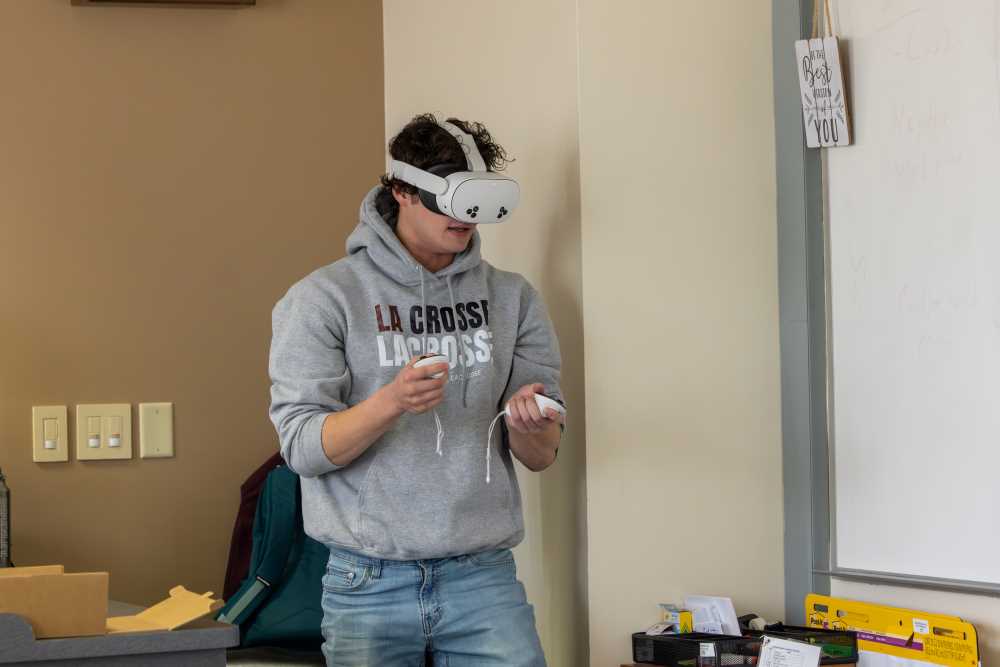Posted 1:24 p.m. Friday, April 25, 2025

UWL Spanish students, professor analyze language learning in the digital age by examining language apps, social media, and the impact of artificial intelligence
In today’s digital age, language learning apps are just a click away, making it easier than ever to study a new language at any time, from anywhere. But how effective are technological tools in helping users master a language?
This spring, Kimberly Morris, UW-La Crosse associate professor of Spanish, and students in her Spanish 443 class took a closer look at the role of technology in language learning, evaluating not only the effectiveness of popular apps, but also the growing influence of artificial intelligence in language education.
What language app will make you fluent?

For those hoping to achieve fluency solely through a language learning app, the results may fall short of expectations, as “there is no shortcut to language learning,” says Morris. Through collaborative research, UWL students examined popular apps like Duolingo, Rosetta Stone, and Pimsleur, among others. While the effectiveness of language learning apps largely depends on the user’s goal, the criteria students identified as most important for an app’s effectiveness included:
• Accessibility (cost)
• Feedback
• Interactivity
• Functionality
• Exposure to both linguistic structures and relevant cultural content
“While certain apps can help users build a basic linguistic foundation through vocabulary and grammar practice, most apps offer limited (or no) features to engage users in real meaningful interactions in different sociocultural contexts,” says Morris.
Students said language learning apps are not a substitute for in-person language instruction but a supplement to it. In-person instruction provides an immersive experience and authentic human interaction, which includes non-verbal cues, cultural context, and emotion — all factors that help them learn.
Best language learning app?

The apps that students ranked best provided them with linguistic input, interactive practice, and personalized feedback in a fun and gamified way. When asked which is the best Spanish learning app, most students preferred Duolingo over others. Among the reasons, they liked how accessible Duolingo is, as a free version is offered.
Thanks to rapid advancements in technology, there are more tools available than ever to help people learn how to interact effectively in other languages. Digital tools such as social media, virtual/augmented reality, and even videogame platforms can expose users to authentic language use and interactions with others. After examining recent research studies and engaging in practical application tasks, the UWL Spanish students believe that these tools allow users “to have fun and still learn at the same time,” thus increasing their motivation to continue learning a language.
What is the impact of AI on traditional language classes?

In the realm of language learning, artificial intelligence (AI) is arguably the most popular yet controversial topic of recent discussion, as AI tools offer both benefits and limitations.
“AI is simply another tool in the language learning toolbox, that, when used responsibly, can support learning due to its accessible, personalized, and interactive nature,” says Morris.
However, because generative AI (like ChatGPT) creates new content based on the available data it is trained on (called large language models, or LLMs), Morris and her students caution its unethical use, as it can promote cheating, biased responses, and an overreliance on technology. According to her students, AI makes a lot of generalizations, which can be harmful when trying to learn about specific cultures, concepts, or dialects.
After analyzing different AI tools and reflecting on their own AI literacy, both Morris and her students agree that, while AI does provide resources to support learning, it will not replace traditional language classes or teachers any time soon.
“Language learning is a human, social, and emotional experience that AI simply cannot replicate,” says Maria Thielen, a student in the class.
For the final project in Spanish 443, students created both a podcast and final paper discussing the impact of AI on traditional language classes, calling on contemporary research and personal experiences to support their arguments.
Small grant supports language research
Morris received a small grant from the UWL College of Arts, Social Sciences and Humanities to explore the impact of artificial intelligence on second language acquisition in Spanish 443. She has also been invited to publish her research on students’ experiences with AI in language learning in the CALICO Journal’s upcoming special issue on AI. The project holds broader potential for curricular innovation at UWL, providing contemporary strategies to enhance language teaching and learning through AI technologies.
Learn more about how UWL professors are exploring AI and learning.
